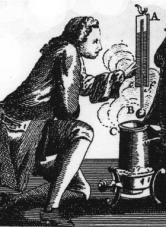Daniel Gabriel Fahrenheit facts for kids
Quick facts for kids
Daniel Gabriel Fahrenheit
|
|
|---|---|
 |
|
| Born | 24 May 1686 (14 May Old Style) |
| Died | 16 September 1736 (aged 50) |
| Known for | Precision thermometry Alcohol thermometer Mercury-in-glass thermometer Fahrenheit scale Fahrenheit hydrometer |
| Scientific career | |
| Fields | Physics (thermometry) |
| Signature | |
Daniel Gabriel Fahrenheit was a brilliant physicist, inventor, and maker of scientific instruments. He was born in what is now Poland to a family of German background. Fahrenheit made huge improvements to how thermometers were designed and built. His thermometers were so accurate that scientists could compare temperature readings reliably.
Fahrenheit is also famous for creating the first successful mercury-in-glass thermometers. These were much better than the alcohol thermometers used at the time. Because his thermometers were so popular, the Fahrenheit scale he developed became widely used.
Contents
The Life of Daniel Gabriel Fahrenheit
Early Years and Education

Daniel Gabriel Fahrenheit was born in Danzig (today known as Gdańsk), a city that was then part of the Polish–Lithuanian Commonwealth. His family, the Fahrenheits, were German merchants who had lived in many important trading cities.
Sadly, when Daniel was young, his parents passed away suddenly in 1701. Daniel and his siblings were placed under the care of guardians. In 1702, his guardians arranged for him to learn bookkeeping and become a merchant in Amsterdam.
After finishing his training, Daniel chose to travel and learn more about science and instrument making. He explored different parts of Europe, including the Holy Roman Empire, Sweden, and Denmark, starting in 1707. He was very passionate about his scientific studies.
Developing Thermometers and the Fahrenheit Scale
Around 1706, Fahrenheit was already making and selling barometers and thermometers that used alcohol. These early thermometers used a temperature scale from Florence, Italy. In 1708, Fahrenheit met Ole Rømer, a famous astronomer in Copenhagen. Rømer showed Fahrenheit his own temperature scale and how he made thermometers. Rømer also told him that there was a great need for accurate thermometers. This meeting inspired Fahrenheit to make his own instruments even better.
Fahrenheit returned to Danzig in 1709 and continued his observations. He traveled more, always working on improving his thermometers. By 1712, he was focused on solving technical challenges with his designs.
In 1713, Fahrenheit began experimenting with mercury for his thermometers. He started using a changed version of Rømer's scale, which later became his own Fahrenheit scale. In 1714, he moved to Berlin and Dresden to work closely with skilled glass-blowers. Around this time, a philosopher named Christian Wolff wrote about Fahrenheit's alcohol thermometers, which helped make Fahrenheit known in the scientific world.
Fahrenheit also had ideas for other inventions, like a mercury clock. He even wrote to the famous scientist Gottfried Wilhelm Leibniz about some of his projects.
By 1717 or 1718, Fahrenheit was back in Amsterdam. He began selling his improved barometers, areometers (instruments to measure liquid density), and his mercury and alcohol thermometers. By 1721, he had perfected how to make and standardize his thermometers. His mercury thermometers were much better than the alcohol ones, making them very popular. This led to his Fahrenheit scale being used widely.
Understanding the Fahrenheit Scale
In 1724, Fahrenheit explained how he created his temperature scale. He used three main reference points:
- The lowest point, which he called 0 °F, was achieved by mixing ice, water, and a type of salt. This mixture creates a very cold temperature.
- The second point, set at 30 °F, was the temperature of still water when ice was just starting to form on its surface.
- The third point, set at 90 °F, was the normal temperature of the human body, measured under the arm or in the mouth.
Fahrenheit believed that mercury boiled at about 300 degrees on his scale. Later, other scientists found that water boils about 180 degrees above its freezing point. Because of this, the Fahrenheit scale was later adjusted. It was redefined so that there are exactly 180 degrees between the freezing point of water (32°F) and the boiling point of water (212°F). The number 180 is useful because it can be divided easily into many smaller parts. This redefinition is why normal body temperature is now considered 98.6°F, instead of the original 96°F on Fahrenheit's first scale.
The Fahrenheit scale was the main way to measure temperature for weather, industry, and medicine in many English-speaking countries until the 1970s. For example, the British Meteorological Office switched to the Celsius scale in 1963 but still used Fahrenheit for public weather reports into the 1980s. Today, most of the world uses the Celsius scale. However, in the United States, temperatures and weather reports are still commonly given in Fahrenheit.
See also
 In Spanish: Daniel Gabriel Fahrenheit para niños
In Spanish: Daniel Gabriel Fahrenheit para niños
- Fahrenheit hydrometer
- List of German inventors and discoverers
- People from Gdańsk (Danzig)
- Anders Celsius

